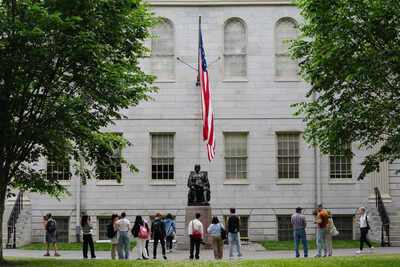
FILE -- People take photos with the John Harvard Statue at Harvard University in Cambridge, Mass. on May 30, 2025. (Sophie Park/The New York Times)
In the global imagination, Harvard University looms like a secular temple of intellect—home to Nobel laureates, Supreme Court justices, and ambitious teenagers with a dream. But long before it became a brand stamped on fleece hoodies and LinkedIn bios, Harvard stood at the bloody crossroads of revolution and nationhood.
In the summer of 1775, its manicured grounds were anything but serene. For a brief, combustible moment, Harvard was not just an Ivy League college—it was the beating heart of America’s rebellion.
The General in the Yellow House
On July 3, 1775, George Washington arrived in Cambridge, Massachusetts, to take command of the fledgling Continental Army. His chosen headquarters? A colonial yellow-frame house tucked inside Harvard Yard, known as Wadsworth House.
At the time, it was the residence of the Harvard president. Washington wasted no time in turning it into a military nerve centre. For nearly two weeks, he held councils of war behind its modest façade, huddled with his generals to map out what would become the Siege of Boston—the first major campaign of the Revolutionary War.This was no ceremonial visit. Washington was walking into a powder keg. British forces controlled Boston; colonial militias were disorganised; and the idea of a united rebellion was still more dream than doctrine.
Yet there he was, pacing in a borrowed house on an elite campus, attempting to rally a people who hadn’t yet declared themselves a nation. That declaration, incidentally, would come almost exactly one year later—on July 4, 1776.
Ivy and iron: Harvard goes to war
As Washington plotted indoors, war arrived on campus. Massachusetts Hall and Hollis Hall, two of Harvard’s oldest dormitories, were transformed into barracks. Over 1,000 patriot soldiers were crammed into rooms once meant for quiet study and theological debate.
The College, overwhelmed, decided to move its academic operations to Concord for safety.But Harvard's contributions weren't limited to logistics and lodging. According to local accounts, the College melted down its own roof lead to supply musket balls to the Continental Army. Yes—Harvard bled for the cause, quite literally. Even the president of Harvard surrendered his residence—Wadsworth House—to General Washington, choosing duty over decorum.
The great tea smackdown
In 1775, tea was more than a beverage; it was a symbol of colonial submission. And Harvard students, predictably, weren’t having it. In an incident that reads like a cross between a food fight and a political protest, two undergraduates smuggled British tea into the dining commons just months after the Boston Tea Party. Their classmates exploded in fury, smashing dishes and condemning the act as treasonous. The college administration responded by banning tea entirely from campus dining—a subtle but powerful gesture of solidarity with the revolutionary cause.This was not the sanitized student activism of modern campuses. This was civil disobedience with consequences, performed under the shadow of real muskets and nearby military engagements. The students may have been young, but their anger was not performative—it was part of a broader defiance that rippled through New England’s intellectual strongholds.
Ink and independence
Harvard’s revolutionary legacy wasn’t just military or symbolic—it was archival.
After the Declaration of Independence was adopted in July 1776, John Hancock, a proud Harvard alumnus and the first signatory of the Declaration, sent a printed broadside of the document to Massachusetts leaders. That very copy is now preserved in Harvard’s Houghton Library, one of the rare surviving originals. The words that would birth a nation—the most famous breakup letter in history—rest in the vaults of the very college that once served as Washington’s war room.Three years later, in 1780, the state of Massachusetts enshrined Harvard’s place in the new republic. The Massachusetts Constitution formally recognised Harvard as a university, bestowing it with the intellectual legitimacy it had long commanded in practice. It was a quiet seal of approval for a college that had helped shape the war from within its own walls.
The past beneath the Ivy
Today, when a freshman walks through Harvard Yard, earbuds in and coffee in hand, she might pause near Wadsworth House for a selfie—or maybe not.
Few realise the gravel beneath their feet once carried Washington’s boots. Fewer still know that the library houses the paper that gave America its name, or that their dorm rooms once echoed with the snores of unwashed soldiers and not the hum of laptops.But that’s the thing about Harvard. For all its elite modernity, its past isn’t embalmed in a museum—it’s embedded in the soil, the stones, the very names etched on brass plaques. Before it was the epitome of American excellence, it was the quiet crucible of American independence.
The rebellion didn’t just pass through Harvard. For one fateful summer, it lived there.

 7 hours ago
52
7 hours ago
52




























 English (US)
English (US)